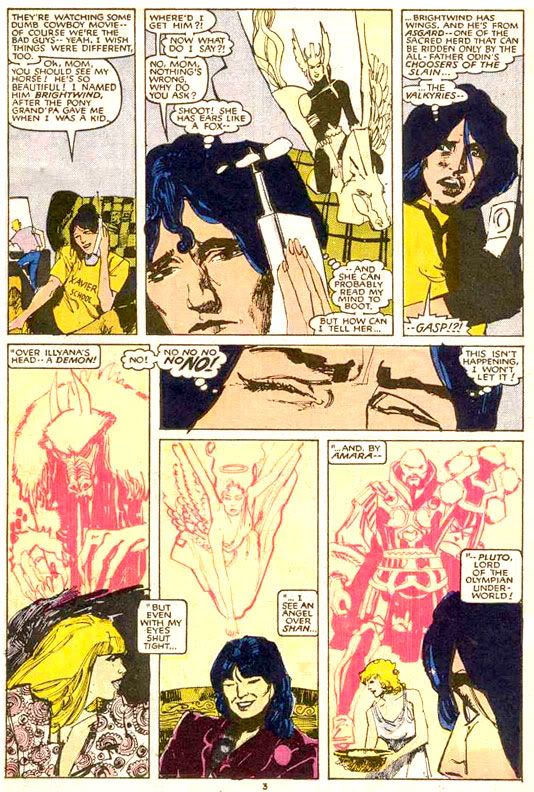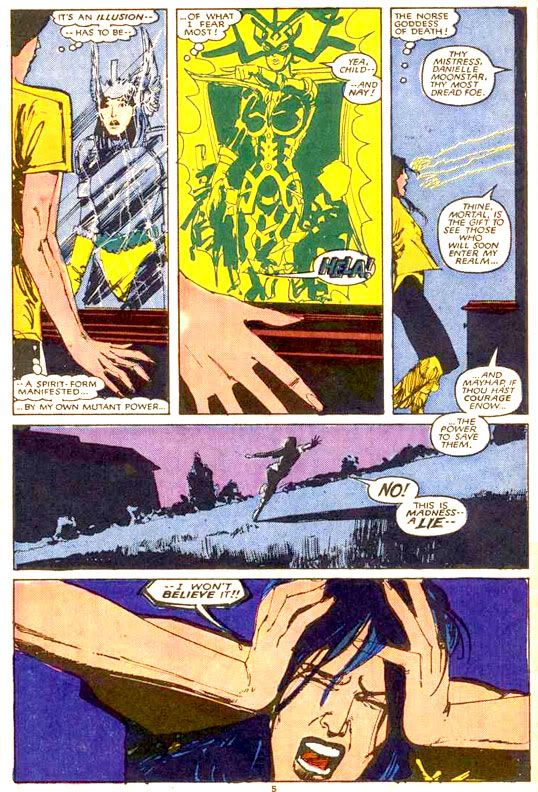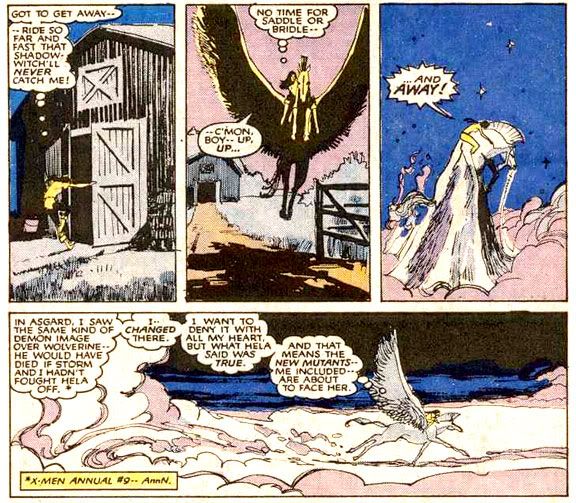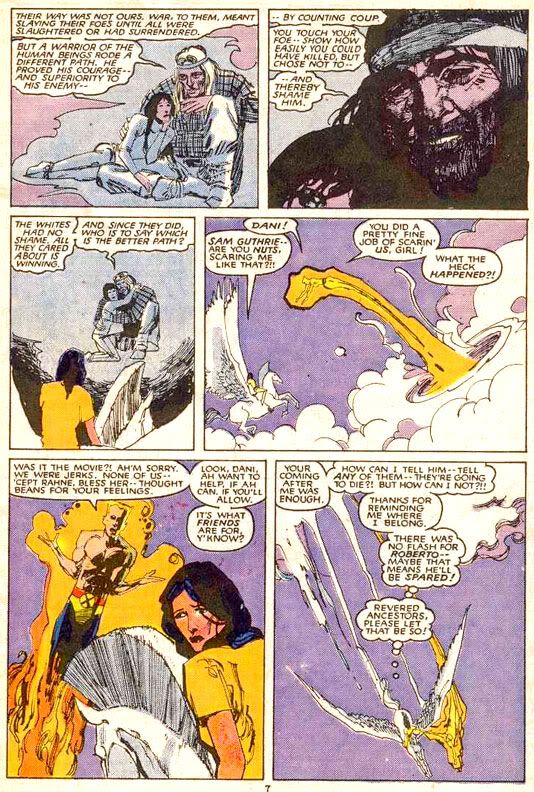 Dani's always had issues. Rage issues. Mental health issues. Comic book issues.
Dani's always had issues. Rage issues. Mental health issues. Comic book issues.Her initial outings with the New Mutants in their monthly are equal parts rage and nervous breakdown. Her mind subtly manipulated by an alien-controlled Professor Xavier, Dani reacts with fear when first confronted by the Danger Room and its virtual reality training exercises. Consumed with self-loathing for her apparent cowardice and betrayal of her Cheyenne traditions, Dani begins to exhibit symptoms of mental illness, escalating from high-risk behavior-- attempting to defeat the Danger Room alone-- to suicidal thoughts. Before the mind-tampering element enters the narrative, it seems Dani is on the path to severe problems. Schizophrenia or something similar. A huge fight alongside the X-Men against the Brood, insectoid authors of many of her problems, and Dani begins to heal, but she remains volatile.
 Here's an example from New Mutants #37 (March 1986). It starts with a typical New Mutants-style scene: the gang are all watching a Western on TV while Dani tries to ignore their insensitivity and have a long distance phone conversation with her mom. It's a John Wayne Western, no less. Fantastic choice, kids. Only Rahne has presence of mind to identify Dani with the culture being so badly portrayed in the movie by various non-Native stunt people and stick up for her friend. While Dani loves her pals enough not to act out in rage when they callously and, frankly, stupidly cheer for the cavalry to kill all those Indians-- hooray for genocide!-- something sets her off. Something always sets Dani off.
Here's an example from New Mutants #37 (March 1986). It starts with a typical New Mutants-style scene: the gang are all watching a Western on TV while Dani tries to ignore their insensitivity and have a long distance phone conversation with her mom. It's a John Wayne Western, no less. Fantastic choice, kids. Only Rahne has presence of mind to identify Dani with the culture being so badly portrayed in the movie by various non-Native stunt people and stick up for her friend. While Dani loves her pals enough not to act out in rage when they callously and, frankly, stupidly cheer for the cavalry to kill all those Indians-- hooray for genocide!-- something sets her off. Something always sets Dani off.This time it isn't so much anger as it is a psychotic break triggered by her Valkyrie power of seeing who will soon die. This issue ends very badly for the New Mutants. Very badly indeed.
In a sequence stunningly illustrated by penciller Mary Wilshire and inker Bill Sienkiewicz, Dani sees the manifestation of death above her teammates' heads and begins hallucinating all sorts of fun things, such as herself in Asgardian armor and Hela, or Hel, the goddess of the underworld in Norse mythology. Hel, who rules over Hel. I'm no scholar of this stuff. I prefer the Greek and Roman pantheons, and the Egyptian. Personal taste.
 Storytelling is key here. Nice acting by Wilshire-- look at the shock and fear on Dani's face contrasted with the blissful ignorance shown by Illyana and Xi'an. As an artist, you have to have an understanding of your characters as individuals and think in terms of their body language and reactions, just as an actor does during a performance. Dani doesn't get mad the same way her hotheaded pal Roberto does, for example. Chris Claremont writes it knowing this, but it's up to Wilshire to interpret it visually and communicate it to the readers.
Storytelling is key here. Nice acting by Wilshire-- look at the shock and fear on Dani's face contrasted with the blissful ignorance shown by Illyana and Xi'an. As an artist, you have to have an understanding of your characters as individuals and think in terms of their body language and reactions, just as an actor does during a performance. Dani doesn't get mad the same way her hotheaded pal Roberto does, for example. Chris Claremont writes it knowing this, but it's up to Wilshire to interpret it visually and communicate it to the readers.Beyond that, I also admire Wilshire's page layouts. The panels read so easily, just a straightforward left-to-right flow, vertical top tier containing one moment, vertical lower tier with quick jump-cuts from Dani's point of view set off by a horizontal one with a close up of her eyes, then the last panel taking us to a more objective viewpoint, which continues on the next page. Dani freaks out at her reflection in the mirror in verticals that continue the sequence inside the house before breaking into horizontals with a location change. This isn't the only way to do this; there are probably many others, all equally effective. Here I really like the pacing. Those tall panels function as quick cuts, emphasizing Dani's sped-up reactionary state, while the wide ones slow things down. She's outside, there are no doubt crickets chirping. She runs across the mansion grounds. The freak-out happens in seconds, it takes longer for her to reach the barn. The three panels where she tears open the barn doors, comes riding out on Brightwind, her magical winged horse, then bursts through a cloud trailing it like gossamer each occur in roughly equal segments of time. Finally, Wilshire draws a panel that stretches the length of the page, expanding the time frame as Dani and Brightwind-- blame that punk mane on Art Adams, I believe-- take a long gallop across the almost endless cloud tops. This moment probably seems timeless to Dani, and yet not long enough.

Even if Chris Claremont hadn't added all the helpful dialogue and thought balloons that explain things, you'd know someone was having an episode, seeing craziness in a mirror, then running outside into the night.
Somewhere in the sky, Dani finds comfort in words of wisdom from another hallucination, this time of her dear, departed grandfather, Black Eagle. This is the kind of thing I used to love about New Mutants-- how the book could go from a mundane moment with the kids eating popcorn and celebrating Manifest Destiny to a fantasy-tinged sequence of a teenaged girl galloping across a silvery, moonlit sky on a winged horse. This happens in a matter of minutes in story-time. And then an exploding yokel appears sans shirt and ruins the magic. It's the way you wanted your life to be when you were 15 or 16 years old. Only if you were like me, you were faced with a daily plethora shirtless yokels and none of the winged horses.
Anyway, that's Dani Moonstar all over. You don't get half-assed reactions from this girl. She's all in, all the time. Well, most of the time. She's the epitome of the Marvel character. She has a strongly defined personality apart from her powers. Your basic Marvel character strikes me as a human being worth reading about whether or not they're a mutant or spider-bit or an irradiated scientist and his equally-irradiated friends. Even if she were a character in some kind of John Knowles A Separate Peace coming-of-age novel, merely a non-powered Cheyenne teen who happened to be studying at an exclusive boarding school back east, with racism, culture clash or self-expectations her major problems rather than anti-mutant hysteria and extra-dimensional kidnappings, Dani would still be touchy, angry and oh so volatile, still interesting in her own right. Now why writers felt the need to change her powers and give her a flying horse, I'll never understand. But that they could do that and have the core Dani remain intact is a testament to her strong conceptualizing by Claremont and Bob McLeod.

2 comments:
Honestly, I think I do know why they may have changed her powers - their wasn't much you could do with them. Her power was making illusions from a person's worse fears and desires, which means that they either worked and Dani won instantly, or they didn't and she was useless.
I remember you saying that Dani's powers were the least interesting thing about her. Apparently the writers agreed, so they kept changing them around.
That's a great point. She's pretty cool even powerless these days. If you come up with a great character, the powers shouldn't matter in the least. People will want to read about her anyway.
Post a Comment